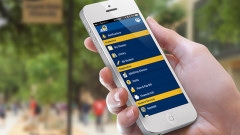The Consumer Barometer with Google here: https://www.consumerbarometer.com/ is full of useful stuff for marketers. The Barometer has 4 sections, and the front page looks like this:
In this post I'm going to use Discover Our Curated Insights to look at how Americans (I could as easily have picked any of 55 other countries from a dropdown menu) use the Internet and online videos to research and buy products and services.
Google presents each factoid in a nice chart like the one below:
But for simplicity I'm going to give you just the facts.
General Internet:
- Americans of all ages use the Internet for personal purposes, ranging from 75% for those aged 55+ to 97% of those aged 25-34.
- 77% of those aged 55+ to 97% of those aged 25-34 do so daily.
- Smartphones are popular for going online. Across age groups, 35% of Americans use a smartphone most often, 33% use a smartphone or a PC/tablet about equally, 21% use PC/tablet more than smartphone.
- 78% of Americans consider the Internet to be their primary resource.
General Shopping:
- They research purchases 77% of the time using PCs, 29% using smartphones.
- Smartphones are most often used (43%) in hte Inspiration phase of product research. But they're also used for Comparison, Advice and Purchase Preparation (all 32%-36%).
- In-store research (16%) as well as Location Search and finding Product Photos (each 14%) are popular pre-purchase activities done using smartphones.
- 36% of smartphone users say they often or sometimes encounter difficulties in using websites.
Local Shopping:
- Top 3 reasons for using online search to find local businesses: Planning Activities (33%), Specific Product Need (25%), Planning a Purchase (24%).
- 80% say their #1 choice for finding a local business is to use a search engine.
- Types of information most often sought about local businesses:
- Prices 52%
- Hours and Promotions (TIE - 33%)
- Location 32%
- Availability and Reviews (TIE - 27%)
- 58% said they use PCs to look for information on local businesses, 43% use smartphones.
International Shopping:
- 31% said they buy products from abroad online at least once a year.
- Top reasons for buying internationally:
- More appealing offers (30%)
- Availability (29%)
- Better payment and service conditions (21%)
- Products most often bought online from abroad:
- Clothing and accessories (35)
- Books and CDs (25%)
- Computer hardware/software (18%)
- 60% of Americans say they find translation to be a hurdle when buying from abroad.
Online Video:
- 66% say they are fully focused on videos they watch
- 66% watch video alone (i.e., no other people present)
- Most (58%) said the videos they watch are short - les than 5 minutes.
- And 58% also said the videos they watched were unrelated to their surroundings at the time
================================
Not bad as research results go, and it didn't cost us a cent!
And it's instructive to look at and compare results from Internet users in other countries - China, for instance.
Some differences that jump out, vs. Americans:
- 75% most often use a smartphone to go online - the most fundamental difference.
- 77% use the Internet primarily for fun.
- 51% use the Internet primarily to get advice when shopping - peer influence!.
- 41% look for local businesses to fill a Specific Product Need.
- 91% - even more than Americans - prefer to use a search engine to find a local business.
- 68% prefer using smartphones to look for local businesses.
- 54% shop internationally because they can get better quality products from abroad.
- Cosmetics and health products are most frequently bought online from abroad.
- Only 10% said they watched videos shorter than 5 minutes - 66% said videos they watched were longer than 10 minutes - do the Chinese have longer attention spans? Could be important - most of us can do a much better job of selling in 10-plus minutes vs. 5-minus.
Look at all that actionable stuff for segmenting American vs. Chinese prospects. And you have 54 other countries from which to pick research results.
Thanks, Google!

 - David
- David







Comments on How to use Consumer Barometer with Google to see how Internet users in any country research and buy